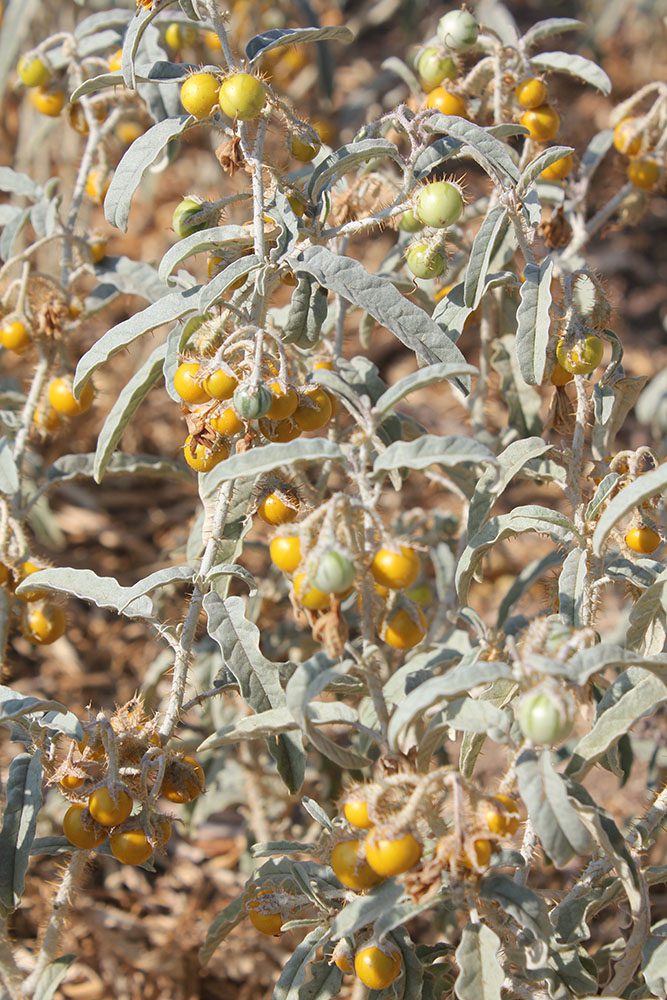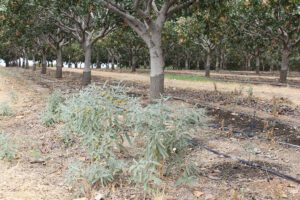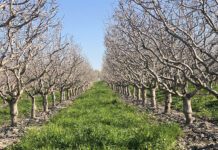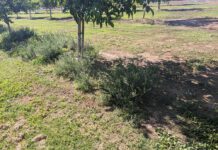
Listen to the audio version of this article. (Generated by A.I.)
If you were going to design the worst weed in existence, silverleaf nightshade (SLN) would check all the boxes. Tolerance to drought, salt and high temperatures; high seed production and extreme persistence in regrowth from root fragments places this weed at the top of the “I don’t want this in my orchard” list.
“We’re not sure how it is spreading from area to area, but it is moving into places where it has not been seen previously,” Jorge Angeles, UCCE weed ecology and management advisor in Tulare, Kings and Fresno counties, confirmed. Distribution of SLN nightshade has been confirmed in all Central Valley counties and in all Southern California counties.
SLN, Solanum elaeagnifolium, is a woody summer weed that spreads by seed and lateral rhizomes. It is a perennial weed native to South America, Mexico and the Southwest U.S. This weed produces small purple flowers and seed berries that change color from green to yellow. Ironically, SLN has a place at the Lady Bird Johnson Wildflower Center in Texas for preservation of the species.
In Tulare and Kern counties, large populations of SLN have invaded orchards, vineyards and open fields. Infestations of this weed are posing problems in newly planted orchards and vineyards, where it is highly competitive with new plantings for water and nutrients, and other weed species.
Angeles stressed SLN is extremely difficult to eliminate once a seed bank has been established in the soil, as seeds can remain viable for years. Its perennial life cycle makes both cultural and chemical controls difficult to achieve. Germination begins in early spring and continues to late summer. This deep-rooted weed germinates from seeds and rhizomes from the previous year. In the summer and early fall, SLN plants can reach 3 feet in height, and one plant can produce about 200 berries, each containing up to 150 seeds. Winter frost will kill the aboveground part of the plant, but the root systems survive and produce new vegetative shoots in the spring, adding to the new plants from seed.
Two of the known ways SLN is spread are by birds consuming the berries and tillage operations that spread the rhizomes.
SLN Spreads Easily
Angeles noted SLN likes loose soil, and seeds easily germinate in loose or sandy soils with even scant moisture. Any soil disturbance in the spring or summer can open the ground to new infestations.
One of the major impacts of SLN is that it competes with young pistachio trees for water, light and nutrients. Dense growth can interfere with irrigation water delivery if not controlled.
SLN ’s tolerance of alkaline and saline soils allows it to outcompete many summer annual weeds and become the dominant weed in the population.
Angeles said there are limited mechanical options for control. Tillage of the soil prior to planting new trees clears the ground but invites germination of SLN seeds. If there was a previous infestation at the site, tillage will drag and spread the rhizomes over a larger area.
Mowing the orchard middles can help deplete the seed bank over time if done before the berries mature and spill the seeds in the fall. However, the seeds can remain viable for years. Discing orchard middles is not recommended because it spreads rhizomes, which can sprout and infest larger areas throughout the year. Equipment used in SLN infested orchards should be cleaned of all plant material to prevent spreading rhizomes and seeds.
To have an effective SLN control program, persistence in herbicide applications and use of a combination of systemic and contact herbicides with different modes of action are needed. These actions also decrease the possibility of SLN developing resistance to a single herbicide. During the summer months, a combination of systemic and contact post-emergent herbicides is recommended to achieve higher levels of control. Using adjuvants, including methylated seed oils, nonionic surfactants, crop oil concentrates or nitrogen-based fertilizers, will enhance the post-emergent herbicides’ efficacy and help with herbicide absorption by the plants. Timing herbicide applications is important in preventing plants from setting seed. More than one herbicide application will be necessary to exhaust the carbohydrates in the root system and kill the entire plant.

Herbicide Trial
Angeles recently completed a Tulare County trial evaluating efficacy of commonly used post-emergent herbicides and Hulk, a newly registered herbicide for use in pistachio orchards. Angeles also evaluated efficacy of sequential applications for controlling established and seedling SLN.
Angeles’ recently completed trial in pistachio orchards rated herbicide control of SLN during two stages of growth, 6 inches and 12 inches. He noted the efficacy of all herbicide treatments in the study varied. Poor coverage of mature plants affected efficacy of herbicides. He also noted it is easier to control plants from seeds rather than those sprouted from rhizomes, due to the seeds’ lack of mature root systems. Rhizomes may look dead from an herbicide application, but they need to be completely dry or they may resprout.
Key findings
Combinations of preemergent and post-emergent herbicides are necessary to control SLN. Application timing is important. Better coverage on smaller plants in less dense populations works best. Do not wait until plants are tall and dense.
For fall herbicide applications, combinations of contact herbicides with glyphosate and glufosinate produced excellent control at both application timings. Treatments with Hulk achieved excellent control when combined with other herbicides and slowed weed resprouting.
Sequential applications provided better weed control by improving coverage on smaller plants compared to a single high-rate application on taller plants.
All sequential herbicide treatments had great control on established and seedling SLN.
High-rate treatments of glyphosate and glufosinate only defoliated established SLN. Plants resprouted from rhizomes.
Applying glyphosate and glufosinate sequentially at lower rates resulted in greater visual control compared to a single application at a higher rate.

Cecilia Parsons | Associate Editor
Cecilia Parsons has lived in the Central Valley community of Ducor since 1976, covering agriculture for numerous agricultural publications over the years. She has found and nurtured many wonderful and helpful contacts in the ag community, including the UCCE advisors, allowing for news coverage that focuses on the basics of food production.
She is always on the search for new ag topics that can help growers and processors in the San Joaquin Valley improve their bottom line.
In her free time, Cecilia rides her horse, Holly in ranch versatility shows and raises registered Shetland sheep which she exhibits at county and state fairs during the summer.















